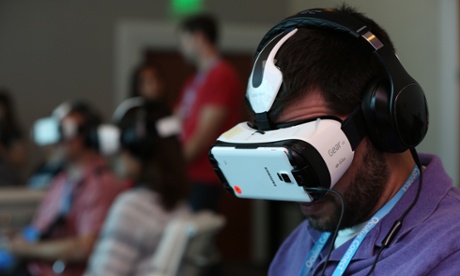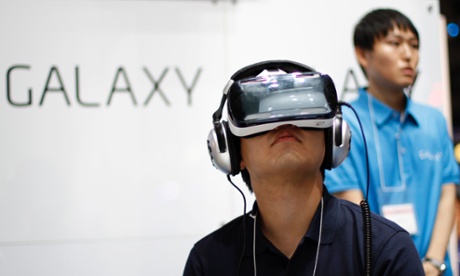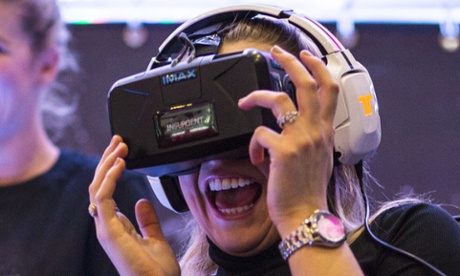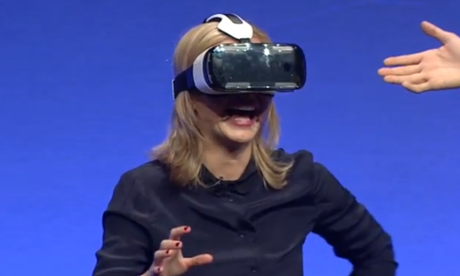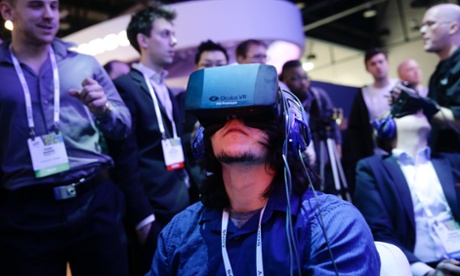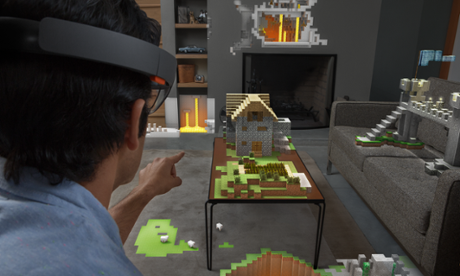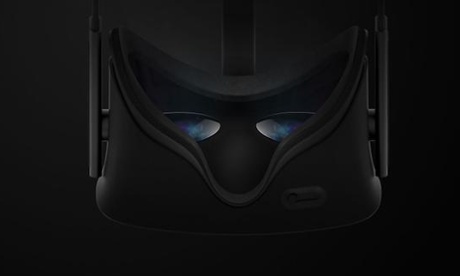I have seen the future, and I’m worried it’s really going to mess me up.
Specifically, I have a cutting-edge virtual reality device, halfway between an old-fashioned Polaroid camera and a snorkel mask, strapped over my face. A few minutes in, I’m no longer sure whether I’m facing forwards, backwards, or simply crouching for dear life as a Tyrannosaurus Rex stomps down the cavernous, echoing hallway of an empty big-city museum – at night. I am, inexplicably, rooted to the spot, not running at full pelt, while T-Rex roars his terrible roar and slobbers his terrible slobber. And then he lurches forward to crush me underfoot.
Back in the real word, which is to say no more than two feet away, I can hear my minder – my guide, my virtual reality goggle-strapper – laughing helplessly as I flinch and weave to dodge T-Rex’s pile-driver legs and his lethally wagging tail.
“That one really got you, didn’t it,” she says.
I don’t begrudge her the moment. She is, after all, trapped in a tiny airless cubicle all day, doing one demonstration after another for the hundreds of people lining up to try a new prototype from Oculus, the pioneering virtual reality developer which has jumped out so far ahead of the competition that it was snapped up by Facebook six months ago for a cool $2bn.
But I am a little angry with myself for suspending disbelief, against my better judgment, and achieving what the virtual reality geeks refer to as “presence” – that is to say, forgetting that my senses and mind are being shamelessly toyed with and behaving, however momentarily, as though the dinosaur staring me in the face were all too real.
In short, Oculus appears to be on to something. It’s been barely two years since the company was just a pushy start-up relying on a Kickstarter crowdfunding campaign, with only the haziest notion of how quickly it could create virtual 3D worlds and make them convincing enough to be commercially viable. Already it is on to a third-generation device that, like its predecessors, will be sold to game developers so they can let their imaginations run rampant and come up with content commensurate with the state of the art.
This model, named Crescent Bay, represents a major leap forward – not only because it captures that lightning in a bottle and achieves “presence”, but also because it no longer induces nausea in most users. Motion sickness is an issue that many gaming enthusiasts have happily overlooked for the past year or two but one that Oculus understands it had to conquer if it is to have any hope of selling virtual reality to the general public – the company’s chief executive, Brendan Iribe, called it “the elephant in the room” before declaring the elephant well and truly slain.
Two weeks ago, Samsung seconded the company’s confidence and announced it was producing the first commercial virtual reality device – essentially, a mobile version of the previous Oculus prototype with a Samsung Galaxy smartphone slapped across the front to act as the screen.
The Gear, as it will be known, was less polished than Crescent Bay when I tested it – it overheated the first time and froze the second time – but it still achieved moments of “presence”, particularly with its 360-degree photographs and videos. The Gear put me on the very top of Berlin’s television tower circa 2002, and the view to the ground was so vertigo-inducing I caught myself clutching the side of the device, to steady myself.
To virtual reality freaks in the gaming world, this feels like a watershed moment – as attested by the wild enthusiasm and clamorous applause of the attendees, most of them game developers, who filled the ballroom of a Hollywood conference hotel to capacity. Iribe, channeling Steve Jobs, made a rock-star entrance from stage right, wearing an Oculus t-shirt, dark designer jeans and a black jacket, and proceeded to talk about the magic revolution he believed he had unleashed.
“This is the Holy Grail,” he said. “We’ve thought about VR for decades. We’ve dreamed about VR.”
Even if this is the beginning of a new era, it is by common consent very early days. Oculus’s chief scientist, Michael Abrash, said the industry still needed “more of everything” – more moving parts, sharper definition, dramatically improved graphics. One demonstration piece put the user in a cinema to watch 3D previews, and while the seating area responded impressively to the different light intensities on screen, the seats were still empty. The reality, at times, felt more congealed than virtual.
For now, VR is largely the domain of gamers, because that is where the enthusiasm and the money is. But attendees pointed to many uses virtual reality machines could have in the near future – allowing a couple renovating their home to see the end-result just from the architect’s plans and check, say, that the kitchen cupboards aren’t too high to open comfortably; or allowing an industry regulatory agency to model the emissions it expects from a factory and show local residents what the sky might look like on an average day.
It seems inevitable, however, that any commercial application would be open to every conceivable form of distortion and deception. Iribe and Abrash talked extensively about the technology being about “tricking” the brain into believing things that aren’t so. “Really, our brains might as well be hooked up to wires and glass jars, given the way we process reality,” Abrash said at one point.
As he talked excitedly about creating the new wave of technological progress, I kept thinking of the scientist in Terminator 2 who believes he is working for the good of humanity – until confronted with the terrifying machines his work will eventually make possible.
It’s not inconceivable that the future could be a Matrix-type scenario in which the “reality” people experience is just a veneer behind which lurks a much uglier world. Or it could be one where people become addicted to self-gratification – everything from virtual sex, engaging all five senses, to virtual dates in which partners living on opposite sides of the world meet in medieval China or 1920s Paris.
The Oculus team may be excited to be riding the crest of this new technological wave, but it also clearly understands this potential dark side. One of the worlds created for the demonstration was a dystopian future city in which the tallest skyscraper was a skinny tower with the Oculus name and eye logo at the top – reminiscent of nothing so much as the sinister, all-seeing tower of Isengard from The Lord of the Rings.
The reference was of course meant as a joke, but it was only so funny.
